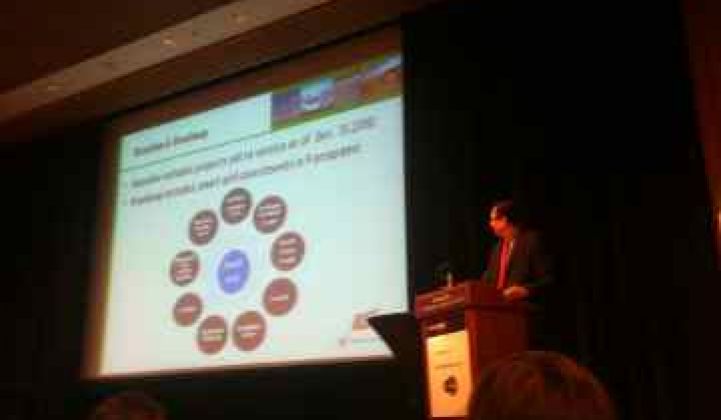San Diego Gas & Electric has installed more than 95 percent of its 1.4 million smart meters. Now, the real work will begin. For all the hype, SDG&E’s Director of Smart Grid, Lee Krevat, said at The Networked Grid in San Francisco that now there is an effort to make sure his organization is reaping the benefits of the investment.
On a panel about the 10-year deployment plans mandated by the California legislature, the state’s three large investor-owned utilities talked about how creating the roadmap has helped to crystallize not only the timeline for implementation, but also some of the expectations of what the smart grid will actually be used for.
“It’s a lot of work to put together a comprehensive plan that an entire organization will commit to and buy into,” Krevat said during his opening keynote address. “Thinking about it holistically really just started in the last year.”
The other two utilities echoed the same sentiment. Understanding how to use the smart grid has required a meeting of minds among companies that, until now, have stayed siloed in their own divisions. Now, Kevin Dasso, Senior Director of Smart Grid for Pacific Gas & Electric, said that departments at his utility were communicating in ways they never had before.
And it’s going to take all hands on deck to fulfill the smart grid plans, which must cover eight areas of focus:
1. Smart Grid Vision Statement
2. Deployment Baseline
3. Smart Grid Strategy
4. Grid Security and Cyber Security Strategy
5. Smart Grid Roadmap
6. Cost Estimates
7. Benefits Estimates
8. Metrics
The panelists agreed that one of the trickiest parts of this process was identifying costs and benefits when technology is moving so fast. Krevat noted that SDG&E was testing a clothes dryer to respond to signals from the utility -- something that he wouldn’t have even been able to imagine three years ago.
Now that the base technology is there, the panelists debated how to get the customer involved:
- Rate differentiation will be the driver for residential customers, said Mike Montoya, Director of Engineering Advancement for Southern California Edison. Once customers have price signals to respond to, then they’ll be more apt to look for technologies to help them shape and control their energy use.
- Third parties are welcome, according to Dasso from PG&E. The hold-up here is standards, but once there are standards in place, the marketplace will respond. Dasso noted that more than a half a million of PG&E’s customers have already accessed the utility's web portal to see their usage.
- Chris Villarreal, Regulatory Analyst in the Policy and Planning Division of the CPUC, took the issue of third parties a step further by bringing up the notion of trust. Let’s face it: most people don’t trust their utilities. But maybe they trust GE or Google. The PUC may be releasing privacy settings as early as this week to help define the expectations for how data can be shared and accessed by these parties.
- All of the panelists agreed that in-home technologies -- beyond maybe a web portal -- would be a market-driven solution. Don’t expect to have your utility (in California at least) provide a full home energy management system -- instead, it will certify that certain products are interoperable with its system. “I think we don’t know where this will end,” said Krevat. “We haven’t seen how customers use the devices. We have goals that we want to achieve and I think there’s a desire to have this be a competitive market.”
- Small commercial is a relatively untapped market; expect to see solutions and more education for that sector along with residential.
Although the utilities are working hard to build value on top of smart meters, there is a whole lot more going on. Here are just some of the projects:
- Dasso spoke of using the meters to monitor voltage at the end points.
- Montoya said that about 500 of SCE’s distribution substations had some sort of automation to them, a project that is ongoing.
- At SDG&E, there are already more than 200 electric vehicles in its territory and some circuits already have more than 30 percent penetration of PVs. Distribution automation is a very real focus in order to handle the fluctuations that the distributed generation is bringing.
- PG&E is looking at how smart grid can offer lower cost options to solve problems. Increasing efficiency and monitoring assets reduces the need to build more. For all of the utilities, condition-based monitoring is just becoming a reality.
- All of the utilities are looking at how they can leverage the streams of information coming in at the back offices. Efficiency isn’t just out in the grid. “We’re incredibly excited about getting rid of all the paper,” said Krevat.
For the three utilities, smart grid cannot be an either/or proposition. It is not just AMI and then distribution automation. It is not only electric vehicles or distribution generation integration. For these three utilities, which are closely watched by others in the industry, mapping a 10-year plan has helped them look not just at what to deploy in the future, but also at what they want to be in the future. “It’s becoming an industry that’s making change,” said Krevat, “change for the better.”



